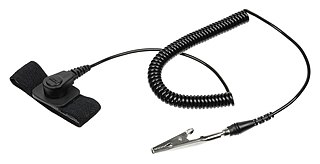
Electromagnetic compatibility (EMC) is the ability of electrical equipment and systems to function acceptably in their electromagnetic environment, by limiting the unintentional generation, propagation and reception of electromagnetic energy which may cause unwanted effects such as electromagnetic interference (EMI) or even physical damage in operational equipment. The goal of EMC is the correct operation of different equipment in a common electromagnetic environment. It is also the name given to the associated branch of electrical engineering.
Conformance testing — an element of conformity assessment, and also known as compliance testing, or type testing — is testing or other activities that determine whether a process, product, or service complies with the requirements of a specification, technical standard, contract, or regulation. Testing is often either logical testing or physical testing. The test procedures may involve other criteria from mathematical testing or chemical testing. Beyond simple conformance, other requirements for efficiency, interoperability or compliance may apply. Conformance testing may be undertaken by the producer of the product or service being assessed, by a user, or by an accredited independent organization, which can sometimes be the author of the standard being used. When testing is accompanied by certification, the products or services may then be advertised as being certified in compliance with the referred technical standard. Manufacturers and suppliers of products and services rely on such certification including listing on the certification body's website, to assure quality to the end user and that competing suppliers are on the same level.

Electrostatic discharge (ESD) is a sudden and momentary flow of electric current between two electrically charged objects caused by contact, an electrical short or dielectric breakdown. A buildup of static electricity can be caused by tribocharging or by electrostatic induction. The ESD occurs when differently-charged objects are brought close together or when the dielectric between them breaks down, often creating a visible spark.

Static electricity is an imbalance of electric charges within or on the surface of a material or between materials. The charge remains until it is able to move away by means of an electric current or electrical discharge. Static electricity is named in contrast with current electricity, where the electric charge flows through an electrical conductor or space, and transmits energy.
The Comité International Spécial des Perturbations Radioélectriques was founded in 1934 to set standards for controlling electromagnetic interference in electrical and electronic devices and is a part of the International Electrotechnical Commission (IEC).
Body capacitance is the physical property of the human body that has it act as a capacitor. Like any other electrically-conductive object, a human body can store electric charge if insulated. The actual amount of capacitance varies with the surroundings; it would be low when standing on top of a pole with nothing nearby, but high when leaning against an insulated, but grounded large metal surface, such as a household refrigerator, or a metal wall in a factory.

An electrostatic-sensitive device is any component which can be damaged by common static charges which build up on people, tools, and other non-conductors or semiconductors. ESD commonly also stands for electrostatic discharge.

The human-body model (HBM) is the most commonly used model for characterizing the susceptibility of an electronic device to damage from electrostatic discharge (ESD). The model is a simulation of the discharge which might occur when a human touches an electronic device.

An antistatic device is any device that reduces, dampens, or otherwise inhibits electrostatic discharge, or ESD, which is the buildup or discharge of static electricity. ESD can damage electrical components such as computer hard drives, and even ignite flammable liquids and gases.
Transmission-Line Pulse (TLP) is a way to study integrated circuit technologies and circuit behavior in the current and time domain of electrostatic-discharge (ESD) events. The concept was described shortly after WWII in pp. 175–189 of Pulse Generators, Vol. 5 of the MIT Radiation Lab Series. Also, D. Bradley, J. Higgins, M. Key, and S. Majumdar realized a TLP-based laser-triggered spark gap for kilovolt pulses of accurately variable timing in 1969. For investigation of ESD and electrical-overstress (EOS) effects a measurement system using a TLP generator has been introduced first by T. Maloney and N. Khurana in 1985. Since then, the technique has become indispensable for integrated circuit ESD protection development.
Teseq AG, formerly Schaffner Test Systems is a supplier of Electromagnetic compatibility (EMC) test equipment and test systems. They develop and manufacture instruments for EMC emissions and immunity testing both for radiated and conducted emissions and immunity. Teseq operates ISO 17025 accredited calibration laboratories with EMC specialization.
An electromagnetic pulse (EMP), also a transient electromagnetic disturbance (TED), is a brief burst of electromagnetic energy. Depending upon the source, the origin of an EMP can be natural or artificial, and can occur as an electromagnetic field, as an electric field, as a magnetic field, or as a conducted electric current. The electromagnetic interference caused by an EMP disrupts communications and damages electronic equipment; at higher levels of energy, an EMP such as a lightning strike can physically damage objects such as buildings and aircraft. The management of EMP effects is a branch of electromagnetic compatibility (EMC) engineering.

The International Certification Accreditation Council (ICAC) is an alliance of organizations dedicated to assuring competency, professional management, and service to the public by encouraging and setting standards for licensing, certification, and credentialing programs.
IEC 61000-3-2Electromagnetic compatibility (EMC) – Part 3-2: Limits – Limits for harmonic current emissions is an international standard that limits mains voltage distortion by prescribing the maximum value for harmonic currents from the second harmonic up to and including the 40th harmonic current. IEC 61000-3-2 applies to equipment with a rated current up to 16 A – for equipment above 16 A see IEC 61000-3-12.
IEC 61000-4-5 is an international standard by the International Electrotechnical Commission on surge immunity. In an electrical installation, disruptive surges can appear on power and data lines. Their sources include abrupt load switching and faults in the power system, as well as induced lightning transients from an indirect lightning strike. It necessitates the test of surge immunity in electrical or electronic equipment. IEC 61000-4-5 defines test set-up, procedures, and classification levels.
IEC 61000-4-2 is the International Electrotechnical Commission's immunity standard on electrostatic discharge (ESD). The publication is one of the basic EMC standards of the IEC 61000–4 series. The European equivalent of the standard is called EN 61000-4-2. The current version of the IEC standard is the second edition dated 2008-12-09. The basic standards (61000-4) are usually called by product or family specific standards, which use these basic standards as a common reference.
IEC 61000-4-4 is the International Electrotechnical Commission's immunity standard based on electrical fast transient (EFT) / burst transients. This publication is part of the greater IEC 61000 group of standards which is covered under IEC TR 61000-4-1:2016. The current third version of this standard (2012) replaces the second version (2004). The goal of this standard is to establish a common and reproducible reference for evaluating the immunity of electrical and electronic equipment when subjected to electrical fast transient/bursts on supply, signal, control and earth ports.






